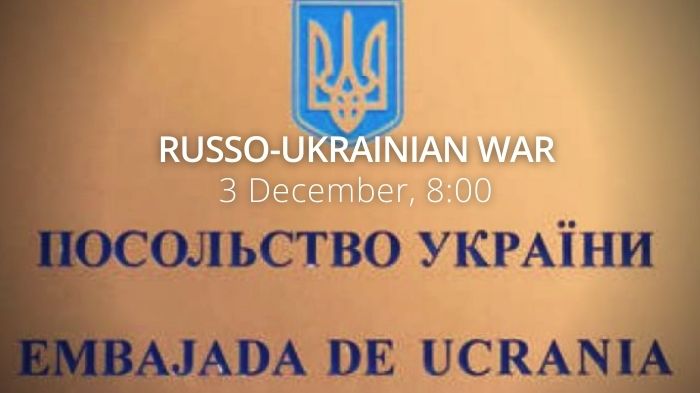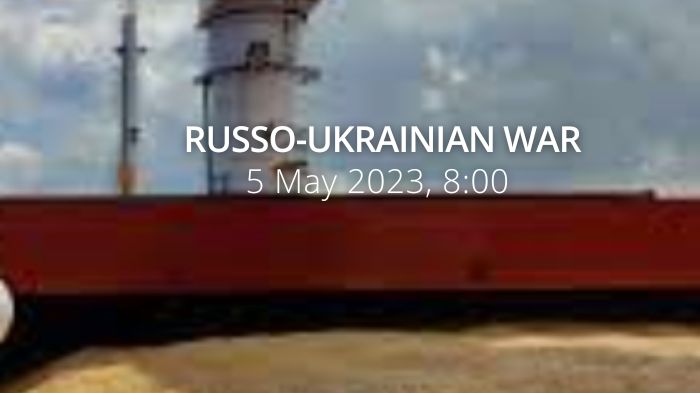Ukrainian embassies and consulates received threatening letters with blood and animal eyes. Ukraine lost 13,000 soldiers killed in action since the start of Russia’s full-scale war — Presidential Office. Ukrainian forces made localized breakthroughs southwest and northwest of Kreminna.
Daily overview — Summary report, December 3
A map of the approximate situation on the ground in Ukraine as of 00:00 UTC 03/12/22.
There have been no notable changes to control since the last update. pic.twitter.com/oWUAQn5JN6
— War Mapper (@War_Mapper) December 3, 2022
The General Staff’s operational update regarding the Russian invasion as of 06.00 am, December 3, 2022 is in the dropdown menu below:
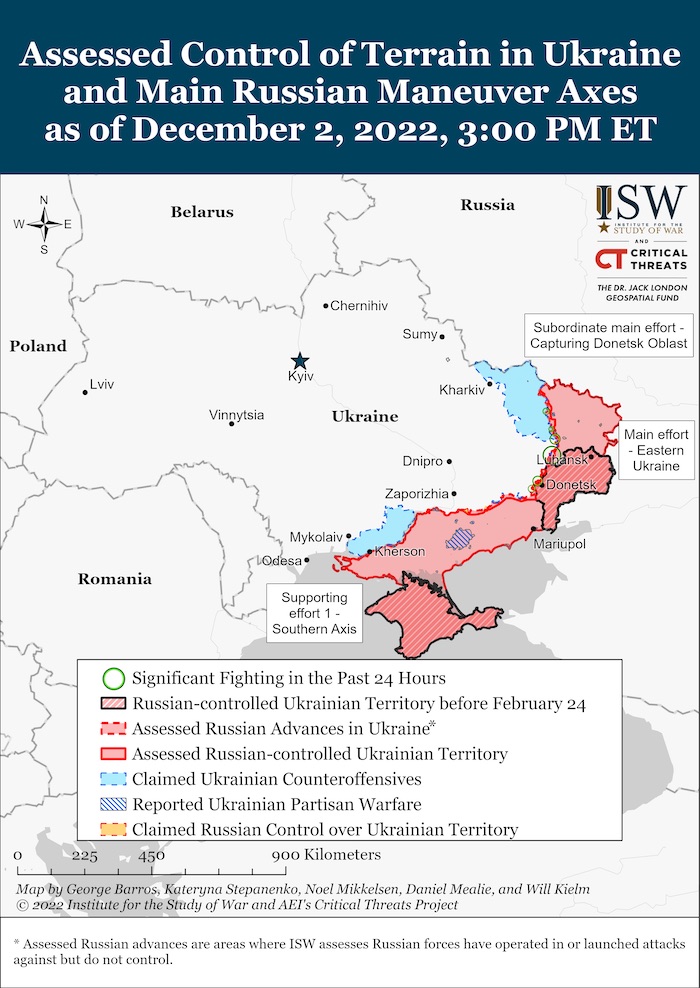
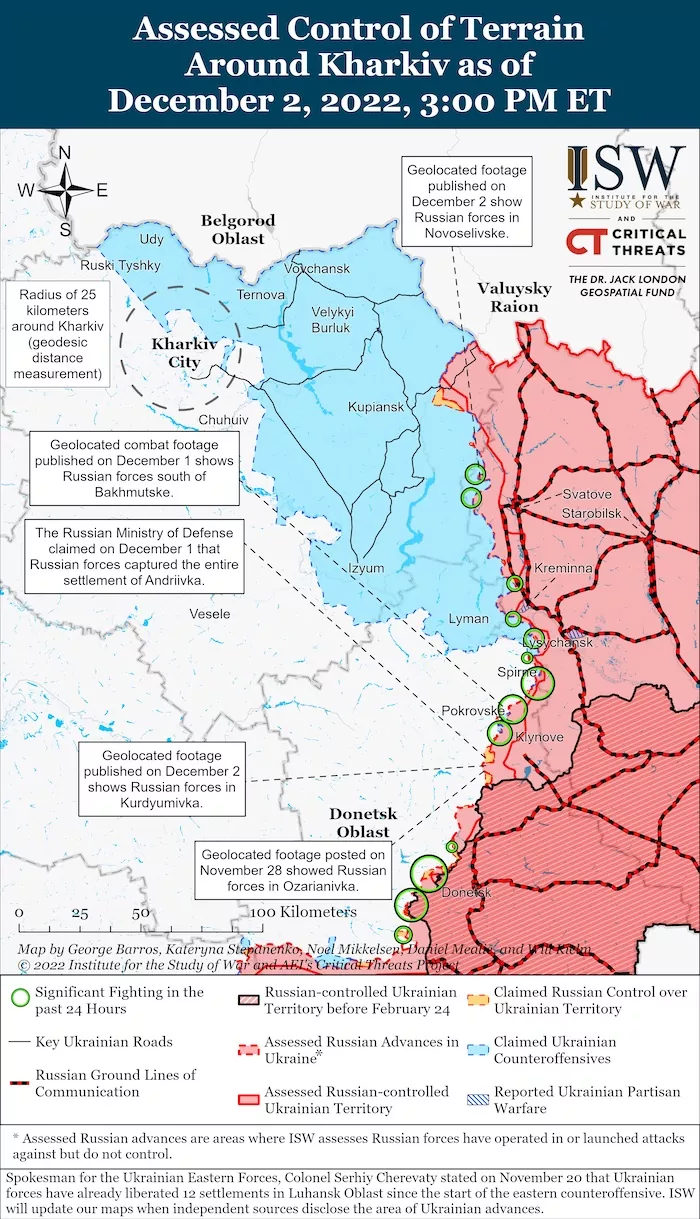
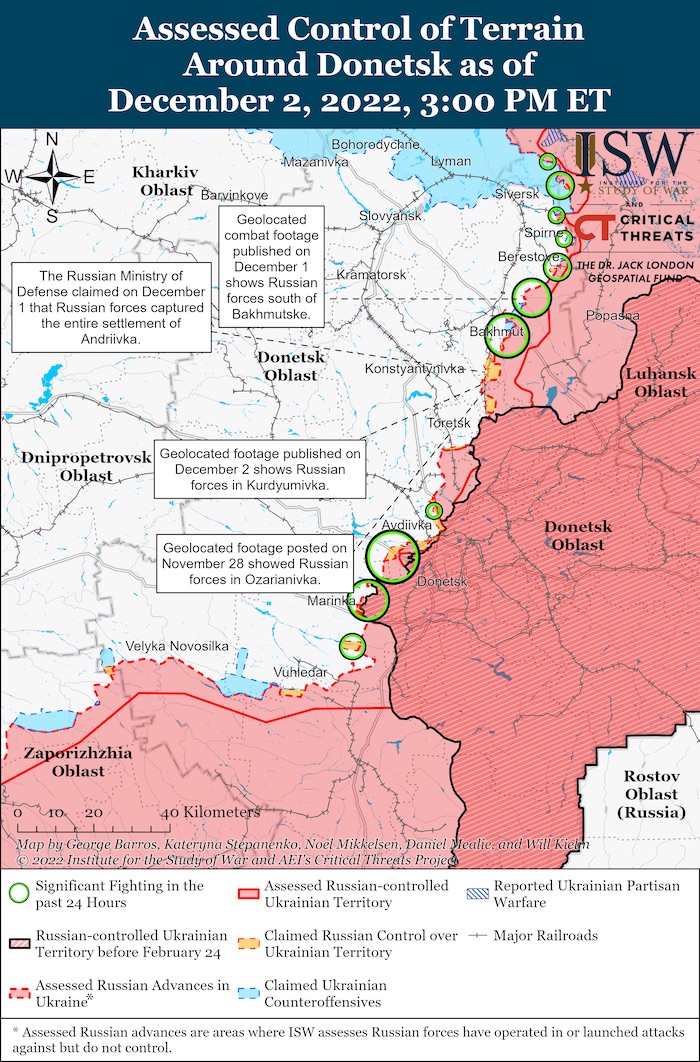
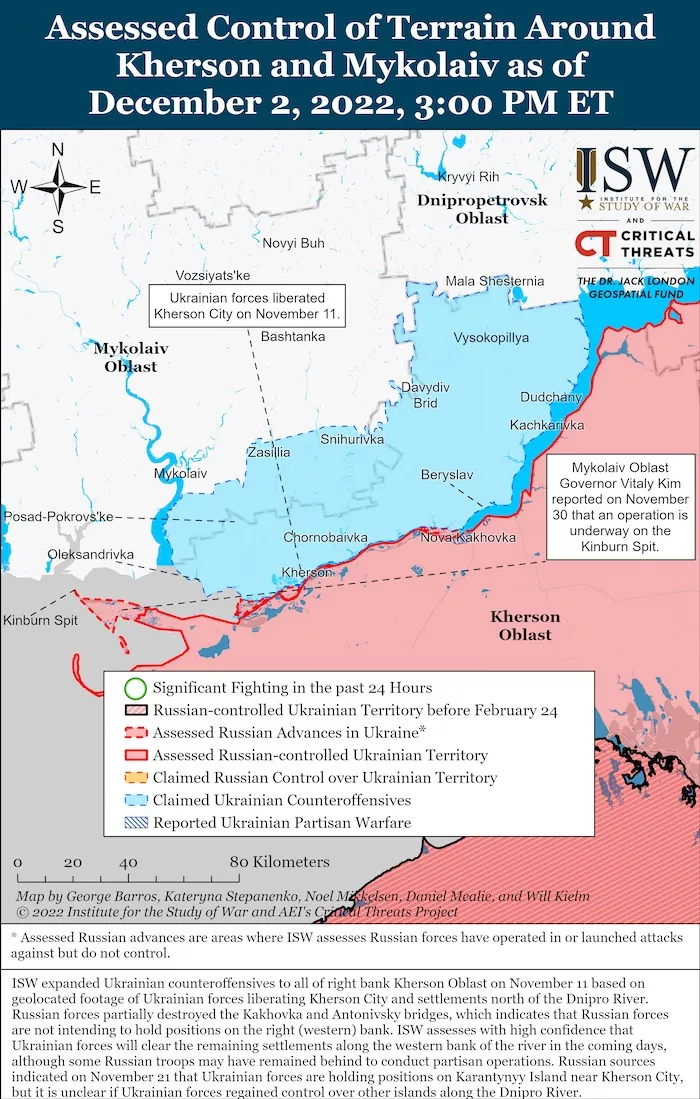
Military Updates
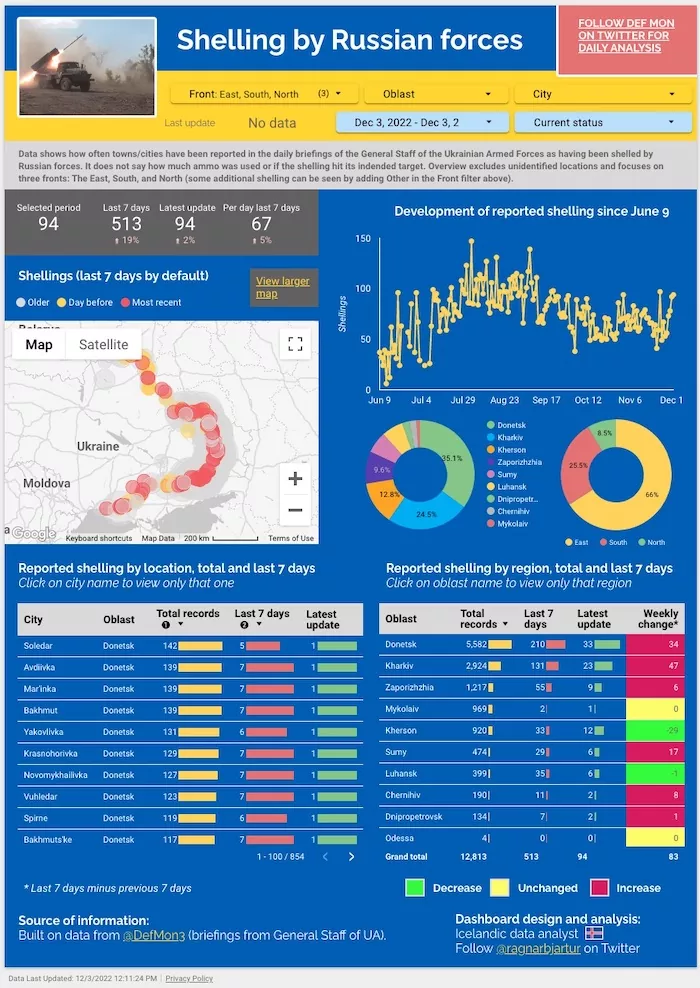
New EU military mission for Ukraine reached full operational readiness – Borrell. “The EU Military Assistance [Mission] for Ukraine is a very tangible proof and illustration of the overall European will to support Ukraine: militarily, financially, economically and politically. Our support is being developed and will continue [being] developed,” Josep Borrell said during his today’s visit to the Brzeg training facility. This Mission is already working and will train 15,000 Ukrainian soldiers. It is going to cost the European Union budget around €100 million and, already, now, 1,100 soldiers are being trained in different camps.
According to British Defence Intelligence, (last 48 hours):
https://twitter.com/DefenceHQ/status/1598634924466229250
- Russian forces continue to invest a large element of their overall military effort and firepower along an approximately 15km long sector of entrenched front line around the Donetsk Oblast town of Bakhmut.
- Russia’s plan is likely to encircle the town with tactical advances to the north and south. In recent days, Russia has highly likely made small advances on the southern axis of this assault, where it is seeking to consolidate limited bridgeheads to the west of the boggy ground around the minor Bakhmutka River.
- Russia has prioritised Bakhmut as its main offensive effort since early August 2022. The capture of the town would have limited operational value although it would potentially allow Russia to threaten the larger urban areas of Kramatorsk and Sloviansk. However, the campaign has been disproportionately costly relative to these possible gains. There is a realistic possibility that Bakhmut’s capture has become primarily a symbolic, political objective for Russia.
Losses of the Russian army
Russian losses in the war have exceeded 90,000 — General Staff. According to the estimations of Ukraine’s General Staff, Russian losses in its war against Ukraine have exceeded 90,000. As of 2 December 2022, 90,090 Russian military personnel has been liquidated, General Staff claimed in its daily updates.
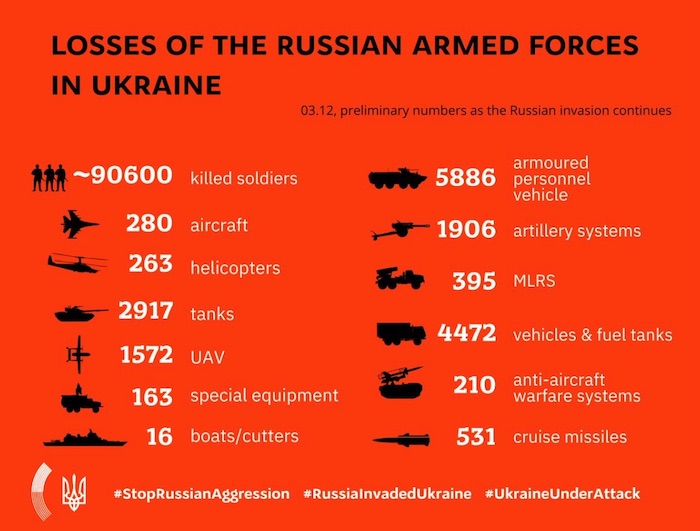
Humanitarian
https://twitter.com/EuromaidanPress/status/1598542978598858754
Vessels linked to Russia’s largest grain trader shipped thousands of tons of stolen Ukrainian grain to global buyers--WSJ. The ships are controlled by Russian businessman Peter Khodykin, who owns RIF Trading, a big player in global grain markets.
Vessels linked to Russia’s largest grain trader shipped thousands of tons of stolen Ukrainian grain to global buyers. The ships are controlled by Russian businessman Peter Khodykin, who owns RIF Trading, a big player in global grain markets. https://t.co/vuBUmYWNVf
— Euromaidan Press (@EuromaidanPress) December 2, 2022
️Environment
Russian troops launched a rocket attack on energy infrastructure in Zaporizhzhia
“Its goal was the destruction of the industrial and energy infrastructure of the regional center. As a result, a fire broke out,” Oblast head said. https://t.co/52fm1ruhXa pic.twitter.com/y7Vly0mevr
— Euromaidan Press (@EuromaidanPress) December 2, 2022
Russian troops launched a rocket attack on energy infrastructure in Zaporizhzhia. On 2 December, over night, Russian troops once again launched a rocket attack on Zaporizhzhia. “Its goal was the destruction of the industrial and energy infrastructure of the regional center. As a result, a fire broke out,” Oblast head Oleksandr Starukh said. According to available data, there were no victims. The fire was extinguished by rescuers, but the infrastructure was damaged.
Russian Gazprom reduced production by almost 20% and exports by 44%; yet exports to China increased.
During 11 months of the year, Russian Gazprom reduced gas production by 19.4% compared to last year, and also reduced exports by 44.5%. This was reported by the company’s press service. “In January-November 2022, according to preliminary data, Gazprom produced 376.9 billion cubic meters of gas. This is 19.4% (90.8 billion cubic meters) less than last year,” the message says.
EU agrees on Russian oil price cap of $60 per barrel after fraught talks – NYT.Diplomats from the European Union agreed on Friday to set a top price of $60 per barrel for Russian oil cargoes, according to Andrzej Sados, Poland’s ambassador to the bloc and a key negotiator of the policy, as well as other E.U. diplomats and officials who spoke on condition of anonymity because they were not authorized to speak with the media, NYT reports.
Legal
US senators call to designate the Russian Wagner Group as a terrorist organization. US Senators Roger Wicker and Ben Cardin introduced the act, bipartisan legislation that would require the Secretary of State to designate the Russian-based PMC Wagner Group as a foreign terrorist organization (FTO).
Latvia launched an investigation as a Russian Riga-based “oppositional” TV channel promoted helping the Russian army. The State Security Service of Latvia launched an investigation because of the expression of the host of the leading Russian “oppositionist” TV channel Dozhd, Aleksey Korostelev, about helping the Russian military. Korostelev spoke live about helping Russian servicemen in the special operation zone in Ukraine.
#Russia invaders deliberately beat haemophiliac from #Kharkiv oblast, threaten to rape his 17-year-old sister #Ukraine #Kozacha_Lopan #StandWithUkraine #RussiaWarCrimes #StopRussia https://t.co/symWxkVd6w pic.twitter.com/3fb5mTXdot
— Halya Coynash (@halyapuff) December 2, 2022
Russians deliberately beat a Ukrainian hemophiliac, and threaten to rape his 17-year-old sister in front of her father. Soon after the Russians invaded Kozacha Lopan, a Kharkiv oblast urban settlement near the border, they came for Oleh Dyhalo, a local politician. They abducted and mercilessly beat up three men – Dyhalo himself, his 29-year-old son, despite knowing that the young man suffers from haemophilia and his nephew.
Support
Spain sent first Hawk anti-aircraft missile complexes to Ukraine
"Received Spanish Defense Minister Margarita Robles in Odesa. We commemorated heroes who died fighting for Ukraine, visited our soldiers in hospital," UA defense minister added https://t.co/Xt6G4qqZT5 pic.twitter.com/fivWbFFMIv
— Euromaidan Press (@EuromaidanPress) December 2, 2022
Spain sent first Hawk anti-aircraft missile complexes to Ukraine. Spain handed over the first Hawk anti-aircraft missile complexes to Ukraine, Minister of Defense of Ukraine Oleksiy Reznikov reported. “Received Spanish Defense Minister Margarita Robles in Odesa. We commemorated the heroes who died fighting for Ukraine and visited our soldiers in the hospital. Spain supports Ukraine: humanitarian and security assistance will continue. More of our fighters will train in Spain. Spain has already provided our first Hawk,” Reznikov wrote.
France helps Ukraine rebuild transport infrastructure. The Ministry of Infrastructure of Ukraine has said that France delivered bridge components to restore transport infrastructure in Chernihiv Oblast.
Sweden allocates new USD 338-million aid package for Ukraine that includes air defense, as stated by Ukraine’s Prime Minister Denys Shmyhal. “The new ‘winter package’ of assistance from the Government of Sweden, totaling about USD 338 million and including, in particular, air defense systems, is a significant contribution to Ukraine’s resilience and victory,” Shmyhal wrote.
Italy extends shipment of weapons to Ukraine for 2023. The Italian Council of Ministers convened by Prime Minister Giorgia Meloni unanimously approved the decree extending the shipment of weapons to Ukraine until 31 December 2023, Italian media Corriere Della Sera writes.
New Developments
Four Ukrainian embassies, and Spanish institutions helping Ukraine receive letter bombs, threats. Four Ukrainian embassies and a string of institutions in Spain helping the Ukrainian Army have received letters with bombs and other threatening substances in the last two days. One of them exploded, injuring one person.
Mafia-style threats are a signature of "Putin's chef" Prigozhin. Non-verbal messages such as dead animal parts by the entrance doors were common in the 90s in St. Petersburg. Read more:
From decade in prison to “Putin’s chef”: who is Wagner CEO Evgeny Prigozhin
Some 6 Ukrainian embassies received threatening letters with blood and animal eyes, as reported by the spokesman of Ukraine’s Ministry of Foreign Affairs Serhiy Nikolenko.“Bloody packages arrived at the embassies in Hungary, the Netherlands, Poland, Croatia, Italy, Austria, the consulates general in Naples and Krakow, and the consulate in Brno. The packages contained animal eyes. The packages themselves were soaked in a liquid of a characteristic color and had a corresponding smell,” Nikolenko said.
https://twitter.com/EuromaidanPress/status/1598575145697714176
Ukraine’s peace deal with Russia will lead to another war – Estonian prime minister. Prime Minister of Estonia Kaja Kallas, in her speech at the non-governmental organization Paasikivi-Seura in Finland, said that Russia would use a peace deal with Ukraine as a pause to regroup and continue its war later.
Ukraine edges closer to banning Moscow-backed Orthodox Church
Zelenskyy informed that NSDC set wheels in motion to ban Ukrainian Orthodox Church of the Moscow Patriarchate (UOC-MP) & initiated an audit of legitimacy of leasing Kyiv-Pechersk Lavra to it https://t.co/o7wxeSzeKG pic.twitter.com/sLANHNzY0q
— Euromaidan Press (@EuromaidanPress) December 2, 2022
Ukraine sanctions clergymen of Moscow-backed Orthodox Church, one bishop under investigation. On 1 December 2022, Zelenskyy signed a decree that imposes personal, including financial, sanctions against the clergymen of the Moscow-backed Orthodox Church in Ukraine.
Assessment
- On the war.
The Institute for the Study of War has made the following assessment as of December 2, 2022:
Russia is attempting to capitalize on the Western desire for negotiations to create a dynamic in which Western officials feel pressed to make preemptive concessions to lure Russia to the negotiating table. Russian President Vladimir Putin held an hour-long telephone conversation with German Chancellor Olaf Scholz on December 2 in which Putin falsely stated that Western financial and military aid to Ukraine creates a situation in which the Ukrainian government outright rejects talks between Moscow and Kyiv and called upon Scholz to reconsider Germany’s approach regarding developments in Ukraine.[1] Scholz stated that any diplomatic solution to the conflict in Ukraine must include the withdrawal of Russian forces from Ukrainian territory.[2] The Putin-Scholz call corresponded with a diplomatic overture from US President Joe Biden on December 1 in which Biden stated that he is prepared to speak with Putin if the Russian president is looking for a way to end the war, although Biden acknowledged that he has no immediate plans to do so.[3]
Kremlin Spokesperson Dmitry Peskov responded to Biden’s comments on December 2 stating that Biden seems to be demanding the removal of Russian forces from Ukraine as a precondition for negotiations and said that the “special military operation” would continue.[4] Peskov added that America’s reluctance to recognize Russia’s illegal annexation of Ukrainian territories significantly complicates the search for common ground in possible negotiations.[5]
Putin’s and Peskov’s statements regarding negotiations follow Russian Foreign Minister Sergei Lavrov’s December 1 comments in the context of a meeting of the Organization for Security and Co-operation in Europe (OSCE) repeating precisely the same demand the Kremlin had made of the US and NATO before the February 24 invasion. Lavrov said that Russian officials will be ready to talk with Western officials if the West shows its willingness to discuss the documents Russian officials proposed in December of 2021.[6] The Russian Foreign Ministry published a draft of its “security guarantees” demands of the US and NATO on December 17, 2021, which called for an expansive list of concessions on NATO and Western military actions in Europe, including, as ISW noted at the time, "a moratorium on NATO expansion, a revocation of the 2008 NATO Bucharest Summit Declaration that Ukraine and Georgia are eligible to become NATO members, a moratorium on establishing military bases on the territory of former Soviet and current non-NATO states, not deploying strike weapons near Russia, and rolling back NATO to its 1997 posture when the Russia–NATO Founding Act was signed.”[7] The Russian Foreign Ministry had issued a statement on February 17 threatening to take “military-technical measures” in response to the refusals by the US and NATO to negotiate on this basis—those military technical measures were the “special military operation” that began a week later.
ISW has previously assessed that Vladimir Putin’s rhetoric indicates that he is not interested in negotiating seriously with Ukraine and retains maximalist objectives for the war.[8] It is likely that Putin, Lavrov, and Peskov made these statements regarding negotiations to create a perception among Western officials that Russia needs to be lured to negotiate. The Kremlin likely intends to create a dynamic in which Western officials offer Russia preemptive concessions in hopes of convincing Russia to enter negotiations without requiring significant preliminary concessions of Russia in return. Putin’s, Lavrov’s, and Peskov’s statements highlight what some of those desired preemptive concessions may be: decreased Western financial and military aid to Ukraine, recognition of Russia’s illegal annexation of Ukrainian territory, and restrictions on NATO and Western military actions in Europe. The Kremlin has also kept its language about the subject of negotiations vague, likely in order to convince Western officials to begin negotiation processes without a clear definition of whether negotiations are in pursuit of a ceasefire, a peace process, or a final peace agreement.
Russia would benefit from a temporary agreement with Ukraine and Western countries that creates a pause in hostilities that allows Russia to strengthen the Russian Armed Forces for future military operations in pursuit of maximalist goals in Ukraine.[9] Putin has shown little interest in such a ceasefire, however, and the Kremlin continues to make demands that are tantamount to full Western surrender, suggesting that Putin remains focused on pursuing military victory.
Western leaders rebuffed the Kremlin’s efforts and reaffirmed their support for Ukraine. Biden and French President Emmanuel Macron in a joint press conference on December 1 reiterated their commitment to support Ukraine in its war against Russia.[10] Biden’s and Macron’s joint show of support for Ukraine and Scholz’s insistence on the complete withdrawal of Russian forces from Ukraine indicate that France, Germany, and the US are not prepared to offer Russia significant preemptive concessions at this time. Biden added that “the idea that Putin is ever going to defeat Ukraine is beyond comprehension.”[11]
Russia may be trying to use its coordinated missile-strike campaign against Ukrainian infrastructure and the associated humanitarian situation in Ukraine to add pressure on Western officials to offer preemptive concessions. Putin falsely stated in his call with Scholz that Russia has been left with no choice but to conduct missile strikes on targets in Ukrainian territory.[12] Russia may be relying on causing undue human suffering, possibly to generate another wave of refugees, to pressure Western officials to offer preemptive concessions because the Russian military has been unable to achieve strategic success.
Russia still poses a threat to the Ukrainian energy grid and civilian population despite Ukraine air defense forces’ high rates of shooting down Russian missiles and drones at the current level of Ukrainian air defense capabilities. Ukrainian General Staff Deputy Chief Brigadier General Oleksiy Hromov stated that Ukrainian air defenses shot down 72% of 239 Russian cruise missiles and 80% of 80 Iranian-made Shahed-136 drones launched throughout November.[13] Ukrainian Air Force Command Spokesperson Yuriy Ignat also noted that Ukrainian and Western-provided air defense systems have been “exhausting” Russian missile stockpiles and forcing the Russians to compensate for dwindling high-precision missiles by using inert Kh-55 designed solely to carry nuclear warheads as decoys.[14] Ignat, however, stated that the use of Kh-55 missiles alongside other missiles and drones is also wearing down Ukrainian air defenses. The small percentage of Russian strikes getting through Ukraine’s air defenses are nevertheless having significant effects on Ukrainian critical infrastructure, with Ukrainian President Volodymyr Zelensky stating that recent strikes had left six million Ukrainians without power ahead of winter.[15]
Russia will likely continue to target Ukrainian critical infrastructure at least as long as enough Russian weapons can get through to achieve effects. The UK Ministry of Defense assessed that Russia’s Destruction of Critically Important Targets (SODCIT) strategy is not as effective as it would have been during the earlier stages of the war, given that Ukrainians have successfully mobilized society.[16] ISW continues to assess that Russian strikes on critical infrastructure are unlikely to break Ukrainian will.
Additional Western-provided air defense systems are prompting the Russian pro-war community to question the long-term sustainability of the Russian missile campaign. Several prominent Russian milbloggers noted that the “build-up” of Western air defense systems in Ukraine is complicating Russia’s ability to conduct missile strikes on Ukrainian energy infrastructure and demanded that the Kremlin speed up its missile campaign.[17] A milblogger even reiterated Western assessments that current Russian missile strikes will have little effect on the frontlines unless “Russians drop their foolishness” and finish the campaign soon.[18] ISW previously reported on similar milblogger concerns over US-provided HIMARS systems, which have allowed Ukrainian forces to conduct successful interdiction campaigns.[19] Such panic among Russian milbloggers highlights the vulnerability of the Russian missile campaign if the West continues to enhance Ukraine’s air- and missile-defense capabilities.
Russia is setting conditions to negotiate the demilitarization of the Zaporizhzhia Nuclear Power Plant (ZNPP) in return for a Ukrainian guarantee of the continued flow of gas to Europe through the Druzhba pipeline, but Russia would likely violate any such agreement and blame Ukraine for not upholding it. Russian nuclear energy agency Rosatom head Alexei Likhachev stated that international negotiations to establish a safety and security zone around the ZNPP in Enerhodar, Zaporizhzhia Oblast continue, and International Atomic Energy Agency (IAEA) Director-General Rafael Grossi stated that he hopes that the IAEA, Russia, and Ukraine will reach an agreement by the end of the year – now less than 30 days away.[20] Russian opposition outlet Meduza reported on December 2, citing its sources within the Kremlin, that Russia is preparing to withdraw from the ZNPP without withdrawing from the area of Zaporizhzhia Oblast that surrounds the plant but did not specify whether the withdrawal would only apply to military units or would include occupation administrators.[21] Such an agreement would likely at least include military personnel and equipment.
The Ukrainian General Staff reported on December 1 that Russia is pulling forces and occupation authorities from various parts of occupied Zaporizhzhia Oblast, and Ukraine’s Main Intelligence Directorate (GUR) reported on December 2 that there are only 500 Russian military personnel at the ZNPP and that withdrawing Russian personnel-planted 300 mines in the industrial zone of Enerhodar.[22] Meduza reported that the Kremlin expects that Ukraine would guarantee the uninterrupted pumping of gas through the Druzhba pipeline, which will become Russia’s main method of transporting gas to Europe on December 5 when the European Union’s embargo against water-transported Russian gas comes into effect.[23] However, as ISW has previously reported, Russia and its proxies have a long history of violating peace deals brokered with Ukraine and other states, then subsequently blaming the other party and leveraging the blame to fail to uphold Russia’s own obligations.[24]
Demilitarizing the ZNPP without a withdrawal of Russian forces from broader western Zaporizhzhia Oblast would not eliminate or diminish the ongoing threat to the ZNPP. Even if Russia did withdraw both its forces and occupation administration from Enerhodar, Russian forces would still control the surrounding area and would retain the ability to strike all the areas they are currently able to strike, including the ZNPP itself. Rather, so long as the military situation remains unchanged in southern Ukraine, Russia would most likely accuse Ukrainian forces of violating the terms of their agreement and use such accusations to justify a remilitarization of the ZNPP and set longer-term information conditions to falsely undermine Ukraine’s ability to safely operate the ZNPP and commit to any future ceasefire or peace agreements.
Key Takeaways
- Russia is attempting to capitalize on the Western desire for negotiations to create a dynamic in which Western officials feel obliged to make preemptive concessions to lure Russia to the table.
- Russian Foreign Minister Sergei Lavrov reiterated as the basis for negotiations precisely the same demands that the Russian Foreign Ministry had made before the February 24 invasion, and Kremlin Spokesperson Dmitrii Peskov added the further demand that the West recognize Russia’s annexation of Ukrainian territory.
- Russian forces still pose a threat to Ukrainian energy infrastructure despite the success of Ukrainian air defenses.
- Additional Western air defense systems are prompting the Russian pro-war community to question the Russian air campaign against Ukrainian infrastructure.
- Russian officials are setting conditions to negotiate the demilitarization of the Zaporizhzhia Nuclear Power Plant (ZNPP), an agreement upon which Russia would likely renege and that would not eliminate or diminish the ongoing threat to the ZNPP.
- Ukrainian forces made localized breakthroughs southwest and northwest of Kreminna.
- Russian forces continued to make minimal advances in the Bakhmut area and conduct offensive operations in the Avdiivka–Donetsk City area.
- Russian forces may be struggling to properly allocate and deploy forces in rear areas in southern Ukraine due to Ukrainian strikes.
- Poor logistics, unruly mobilized personnel, and domestic protests continue to prevent the Kremlin from achieving the goals of partial mobilization.
- Russian President Vladimir Putin continues to attempt to mask military development projects in occupied territories for no obvious reason.

